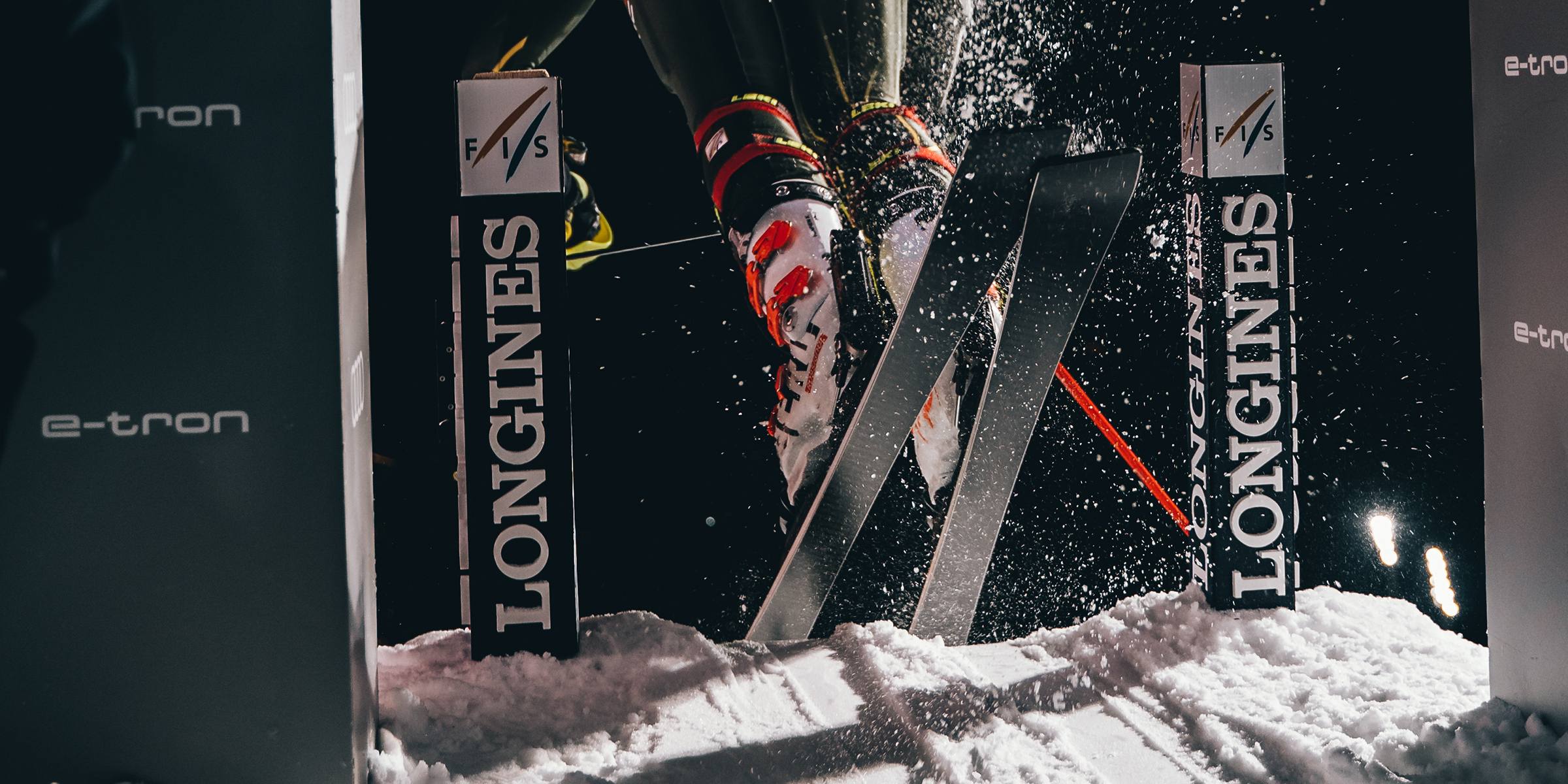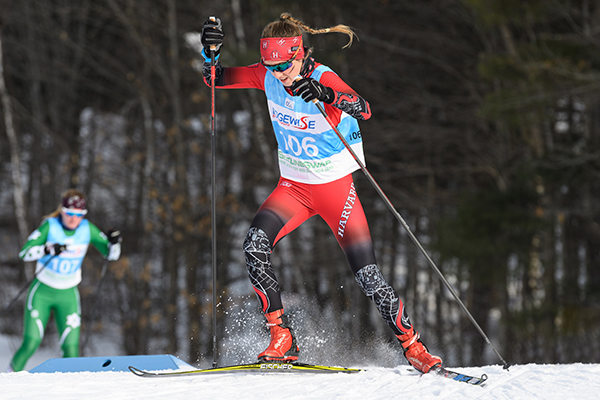The Woman Behind the Numbers: How Lily Koffman Helps Mold Better Athletes Through Science

U.S. Ski & Snowboard athletes perform quite literally on the edge—on their skis and their boards—gaining an edge over the competition is the difference between earning a podium or not, and in one medal versus another. As skiing and snowboarding has evolved over time, so too has U.S. Ski & Snowboard’s understanding of what makes an athlete successful. When the difference between success and failure is on the edge, finding a competitive advantage becomes paramount.
Enter Lily Koffman. In 2019 during her senior year of undergrad, Lily read an article in Faster Skier describing U.S. Ski & Snowboard Performance Data Manager Gus Kaeding’s work using data to better inform Team criteria, specifically for the cross country team. As an undergraduate at Harvard University studying statistics on the hunt for a thesis project, and a member of the Harvard Cross Country Ski Team, Lily thought to herself: “That’s cool. I wonder if he needs any help.” Her outreach to Gus led to a summer fellowship, funded by the American Birkebeiner Ski Foundation and Women in Sports Tech, which just wrapped its second year. Although Lily didn’t find her senior thesis, she is playing an instrumental role in helping U.S. Ski & Snowboard mold better athletes through science.

Athletes and coaches are no strangers to collecting and analyzing data, including: daily nutrition, sleep habits, levels of fatigue and stress, repetitions and loads in the gym, number of jumps, number of training runs, snow conditions, etc. But how do you turn those numbers and logs into useful information and calls to action? Think of Lily and Gus as the codebreakers; these two analyze and interpret data across all sport disciplines for meaningful insights.
“A lot of the information we have previously relied on [for developing athletes] is anecdotal,” explained Gus. “I think especially in skiing and snowboarding we have lots of opportunities to make decisions going forward based on fact, not just something your coach told you that his or her coach told them before that.”
Gus started with U.S. Ski & Snowboard three years ago and since then has streamlined how athlete data is collected, managed and analyzed. “Now we have enough data that we can have these dedicated projects and attract talented people like Lily to help us. We have the problem, here’s the data, now solve this.”
Lily focused on three major projects for U.S. Ski & Snowboard including analyzing Mikaela Shiffrin’s data, the entire Alpine development system, and ACL injuries across sport. And because she’s partially funded by the American Birkebeiner Ski Foundation (Birkie), she investigated female participation in the Birkie event.
The American Birkebeiner is the largest, and one of the longest, cross country ski races in North America. It sees about 20% female participation annually and the organization employed Lily to make recommendations, based on the data, of what they could do to attract and retain more women. Through her research, Lily found that this problem isn't unique to the Birkie. Lily was surprised to learn that the Norwegian Birkebeiner also has about 20% female participation as well.
“Skiing is super popular in Norway. [So these findings were] somewhat reassuring. It’s not specific to the American Birkie, but a worldwide problem in skiing. Conversely, world marathon running participation is about 40% female. So there’s lessons to be learned, what did running to do increase participation and how can we apply this information to skiing?”
Lily made several recommendations based on running’s successes. “A lot of growth in women’s distance running is attributed to social and charity running groups. Skiing can benefit from a similar focus on community and charity. It’s also important to make marathon skiing more accessible. On snow training every day isn’t essential to being able to ski the Birkie. There’s this perception of this really competitive culture. If you’ve never done a ski marathon it’s hard to show up and have confidence that you can do it too, especially if you don't have a skiing background.”
Lily recommended training plans and equipment guides, similar to what’s prevalent in the marathon world, as well as identifying community ambassadors who can encourage women to try skiing the Birkie, and to come back year after year.
As a woman in a largely male-dominated field, Lily’s perspective as a woman can help bring women-specific issues to the forefront of sport science. A review of 1,382 exercise medicine studies published between 2011 and 2013 found that females made up 39 percent of total study participants. Among 188 studies published in two academic journals in early 2015, females made up 42 percent of study subjects. Among studies in sport science, females accounted for only three percent of participants.
“I think it's one of the things that I am personally interested in,” Lily said. “It’s important to grow the presence of women in data roles so [more people start] paying attention to the gender angle. I’m trying to do my part to make [those stats mentioned] more 50% [across the board].”
Lily’s first project with U.S. Ski & Snowboard was to overlay two-time Olympic champion, five-time World Champion and winningest slalom skier of all-time, Mikaela Shiffrin’s training and wellness data with her race data to discover what the most important variables were in the week before a race. It was an exciting endeavor, but not as straightforward due to Mikaela’s overall success, “It’s a hard thing to look at, to measure performance, especially with someone like Mikaela,” Lily explained. “The problem is, what is success? [Mikaela] might win, and she wins often, but it might not be a ‘great’ race.”
“Because Mikaela wins so often, having a win doesn’t really tell you how good of a race it was itself,” added Gus. Lily had to come up with a new metric that showed which races were actually Mikaela’s best performances. Lily presented this information to Mikaela’s team earlier this summer, with the intention of repeating the process this season, to determine successes and new learnings.
From there, Lily took on the daunting task of analyzing the entire alpine development system from youth to National Team athletes, as well as NCAA skiers. “This was the first comprehensive analysis that lays out the entire alpine environment from youth to elite skier,” said Gus. “It was a pretty hard analysis. We’re fortunate to have Lily for this because I’m pretty confident that she is one of few in the entire ski world who has the skill to do such a task; it’s very complex. [We now have a] historical analysis from everything that’s happened (how skiers move through the system compared to other nations), which can help shape the direction going forward.”
“Going into a project I have no goal of what I want to see,” Lily explained. “[For the alpine project] the question was ‘What does the career path of different skiers in the U.S. look like?’ The first step is to make a lot of visualizations. Then something might grab my attention, so I focus on that aspect.”
Although her fellowship is wrapped for the summer, Lily will continue to work on the ACL project as she pursues her master’s degree in biostatistics at Harvard this year. This is of particular interest to U.S. Ski & Snowboard, as being able to actively prevent season and career-ending injuries could be a serious game changer.
“Our ACL data is among the biggest data sets of ACL injury that I have ever seen,” explained Gus. “One thing that we have that no other ACL data sets have is that we know a lot of what athletes are doing before they were injured.” Other ACL data sets mostly come from a medical perspective, the starting point for this data is once the person is injured, not what happened beforehand. “For [our athletes] we know their strength numbers in the gym, what kind of snow they were skiing on, how many snow days in a row they had… we know if they had traveled the week prior, if there was another existing injury beforehand. There’s lots of things to look at.”
“[I want to see] if I can identify any trends in who is getting injured, what they were doing when they got injured and return to snow timeline protocols,” said Lily.
“No data set is perfect,” said Gus. “But we have the whole lifecycle and as much data as you could hope for given the lack of frequency we have for this injury. Our goal is to continue [that trend] of lack of frequency [in ACL injuries].”
Data analysis is increasingly a critical element in high performance innovation. Using data to first identify problems and then make decisions based on proven trends means working smarter. Having talented, passionate individuals working behind the scenes making sense of what’s actually happening in the field is crucial in empowering athletes to reach their full potential.
“We’re fortunate because we have cool things to work on,” said Gus. “That’s attractive for a young person in the field of data. We should be taking advantage of these young people who think differently [than how I or someone else was taught].”
U.S. Ski & Snowboard is taking applications for its female data fellowship program for 2021. If you’re a female in sports tech interested in opportunities with U.S. Ski & Snowboard, please contact Gus Kaeding at gus.kaeding@usskiandsnowboard.org.
About the American Birkebeiner® Ski Foundation
Located in Hayward, Wisconsin, the American Birkebeiner Ski Foundation (ABSF), a 501(c)(3) organization, is known for its signature American Birkebeiner “Birkie” Ski Marathon held each February. The ABSF creates inspiring events to assist all ages and abilities in living a healthy, active lifestyle. Learn more at www.birkie.com.
About Women in Sports Tech, Inc.
WiST is a non-profit organization driving growth opportunities for women in sports tech and innovation, from interns to executive leadership roles, while providing a pathway for highly motivated college students to discover and explore opportunities within the field. Corporate support includes Nike, IBM Sports, the NBA, Spartan Race, and Catapult Sports. To learn more about how WiST is working to #ChangeTheRatio for women, go to womeninsportstech.org.
